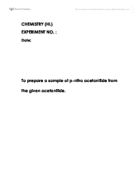Melting and Freezing point of Naphthalene
Research Question
- What is the specific temperature for the melting point and freezing point of naphthalene?
Background
During the lab experiment, we are going to place the Naphthalene on the gauze mat which will be kept above the Bunsen burner using a retort stand. A matter can be classified as solid, liquid, or gas and they are known as the three states of matter. We know that particles during the melting process move faster than particles that are in the solid state due to their high kinetic energy. Particles also move slower as the matter changes back into solid due to solid’s low amount of kinetic energy. Kinetic energy is the energy that makes the particles move. When the matter is in its solid state, the particles are stuck together in such a way that they do not move; however, when matter is in its liquid state the particles slide over each other. For gas, the particles move freely in the container it’s in. Solid is a definite shape while liquid and gas are indefinite. Solids stay the same shape while liquids and gasses take the shape of the container it’s in.
Hypothesis
The melting point of Naphthalene is 80°and the freezing point of Naphthalene is 60°.







